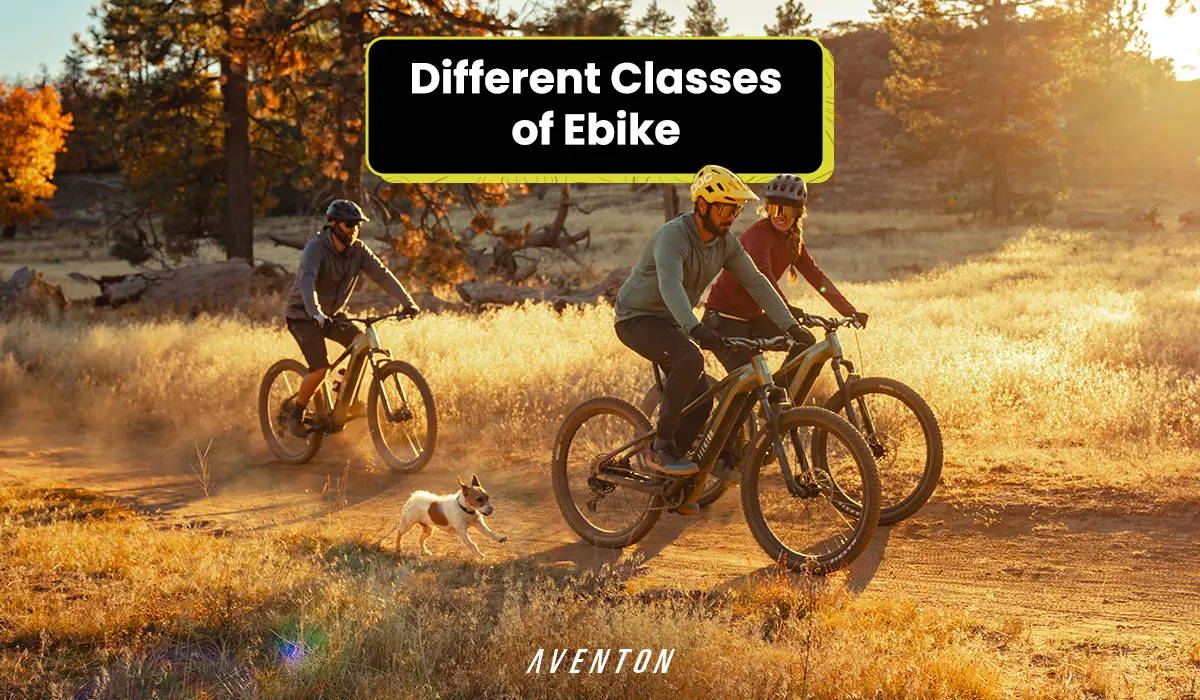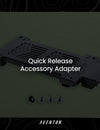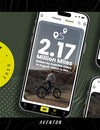
Ebike Classes 1, 2, and 3: How Do They Differ?
October 3, 2024
Ebike classes are a means to categorize electric bikes to specify what features each bike has and how fast they go. This is especially important for determining what's allowed on specific trails, parks, and other paths to adventure.
Choosing between ebike classes 1, 2, or 3 depends on what your desired intended use will be. Luckily for you, we’re here to educate and help you along the way with choosing the type of electric bike that best fits your lifestyle.
Here’s what we’ll be discussing in this article:
1a. What Are Class 1 Ebike Laws?
2. Aventon Class 1 Ebikes for Sale
2a. What Is the Best Class 1 Electric Bike?
3a. What Are Class 2 Ebike Laws?
4. Aventon Class 2 Ebikes for Sale
5a. What Are Class 3 Ebike Laws?
6. What Are the Differences Between Ebike Classes 1, 2, and 3?
What Is a Class 1 Ebike?
Class 1 ebikes are pedal-assist-only ebikes with a top speed of up to 20 mph and no throttle. Pedal assist on an ebike is a feature where the electric motor provides additional power as you pedal, making it easier to ride, especially on hills or over long distances.
Class 1 ebikes are popular for their balance of assistance and cycling experience, making them suitable for a variety of users, from commuters to recreational cyclists. They also provide riders with access to bike paths and trails where other classes of ebikes are not permitted.
What Are Class 1 Ebike Laws?
The maximum speed for class 1 ebikes is 20 mph, and a driver’s license is not necessary to ride one in most states. More than 30 states have adopted the three-class system, but in the other states, ebikes may be classified as motorized vehicles, so it’s important to check local regulations.
In order to ride an Aventon ebike, you must be 16 or older. Class 1 ebikes are specifically designed for the accessibility of mountain bike trails and other roads and bike pathways where other ebike classes are not allowed.
Key features:
- ✓ Pedal Assistance: Yes
- ✓ Throttle: No
- ✓ Max assisted speed: 20 mph
- ✓ Speedometer: Not mandatory
Aventon Class 1 Ebikes for Sale
What Is the Best Class 1 Electric Bike?
Want to find the best class 1 electric bikes? The Aventon Ramblas is our top pick with its max speed of 20 mph and three levels of pedal assist (Eco, Trail, and Turbo). With 130mm of suspension travel, S Maxxis Rekon tires, and 100 Newton-meters of torque, the Ramblas is designed to conquer rough off-road terrain. Features include a SRAM NX 12-speed drivetrain, hydraulic disc brakes, and mid-drive motor with 250 watts of sustained power and 750 watts of peak power.
Highlighted specs:
- ✓ Max speed: 20 mph
- ✓ Battery range: Up to 80 miles
- ✓ Torque sensor: Yes
- ✓ Payload: 300 lbs
- ✓ Warranty: Two-year warranty
- ✓ Throttle: No
What Is a Class 2 Ebike?
Class 2 ebikes have both pedal assist and a throttle, with a maximum speed of up to 20 mph. A throttle on an ebike is a feature that allows you to control the bike's motor power without pedaling. By twisting a handle or pressing a button, you can engage the motor.
Class 2 ebikes are popular among those who may want the option to ride without pedaling, such as for tackling hills or long distances with less physical strain.
What Are Class 2 Ebike Laws?
Class 2 ebikes follow the same road rules as traditional bicycles and are typically allowed on roads with speed limits of 30 mph or less. They can also be used on bike lanes and shared-use pathways and are permitted to carry passengers.
Ebikes and the different classes of ebikes are subject to state laws. For example, in Florida, class 2 ebikes are considered bicycles. This means riders don’t need a license or registration to operate them.
Key features:
- ✓ Pedal assistance: Yes
- ✓ Throttle: Yes
- ✓ Max assisted speed: 20 mph
- ✓ Speedometer: Not mandatory
Aventon Class 2 Ebikes for Sale
What Is the Best Class 2 Electric Cargo Bike?
The Aventon Abound SR is the best electric cargo bike for anyone seeking power, performance, and versatility in one sleek package. With a top speed of 20 mph and a range of up to 60 miles, it effortlessly handles daily commutes, errands, and more.
Its 750-watt rear hub motor provides 80 Nm of torque, ensuring quick acceleration and hill-climbing strength, even when loaded with up to 440 lbs of cargo. Plus, security features such as 4G GPS smart tracking and theft deterrence.
Highlighted specs:
- ✓ Max speed: 20 mph
- ✓ Battery range: Up to 60 miles
- ✓ Torque sensor: Yes
- ✓ Payload: 440 lbs
- ✓ Warranty: Two-year warranty
- ✓ Throttle: Throttle on demand
What Is the Best Class 2 Electric Bike?
With a maximum speed of 20 mph, an on-demand thumb throttle, and four levels of pedal assist (Eco, Tour, Sport, and Turbo), the Aventon Abound is the best class 2 electric bike. This cargo ebike can haul up to 440 pounds, including 143 pounds on the rear rack. It features an integrated storage bag, passenger footboards, fenders, and front and rear lights with integrated turn signals.
Highlighted specs:
- ✓ Max speed: 20 mph
- ✓ Battery range: Up to 50 miles
- ✓ Torque sensor: Yes
- ✓ Payload: 440 lbs
- ✓ Warranty: Two-year warranty
- ✓ Throttle: Throttle on demand
What Is the Best Class 2 Folding Electric Bike?
The Aventon Sinch.2 is the best class 2 folding electric bike with a top speed of 20 mph, a thumb throttle, and four levels of pedal assist. Powered by a 750-watt rear hub motor and a torque sensor, it has four-inch wide fat tires to handle any terrain. A front suspension fork provides a smooth ride, while fenders protect from splashes.
Highlighted specs:
- ✓ Max speed: 20 mph
- ✓ Battery range: Up to 55 miles
- ✓ Torque sensor: Yes
- ✓ Payload: 300 lbs
- ✓ Warranty: Two-year warranty
- ✓ Throttle: Throttle on demand
What Is the Best Class 2 Electric Bike Under $1,500?
At $1,199 MSRP, the Aventon Soltera.2 is the best class 2 electric bike under $1,500. The 350-watt motor and four levels of pedal assist reach top speeds of 20 mph with an on-demand throttle. Weighing just 46 pounds and featuring an aerodynamic frame, it’s agile and offers responsive handling thanks to a larger rotor.
Highlighted specs:
- ✓ Max speed: 20 mph
- ✓ Battery range: Up to 46 miles
- ✓ Torque sensor: Yes
- ✓ Payload: 300 lbs
- ✓ Warranty: Two-year warranty
- ✓ Throttle: On demand
What Is the Best Class 2 Fat Tire Electric Bike?
With four-inch wide tires and a powerful 750-watt motor, the Aventon Aventure.2 is the best class 2 fat tire electric bike. It reaches speeds of 20 mph, has an on-demand throttle, and four levels of pedal assist. Ride it up to 60 miles on a single charge, and enjoy features like front and rear lights with turn signals plus a front suspension fork with 80mm of travel.
Highlighted specs:
- ✓ Max speed: 20 mph
- ✓ Battery range: Up to 60 miles
- ✓ Torque sensor: Yes
- ✓ Payload: 400 lbs
- ✓ Warranty: 2-year warranty
- ✓ Throttle: Throttle on demand
What Is the Best Class 2 Commuter Ebike?
The Aventon Level.2 is the best class 2 commuter ebike with a top speed of 20 mph and five levels of pedal assist. Features include a torque sensor, front suspension fork, and a 500-watt rear hub motor. Use the rear rack to haul gear, stay dry thanks to integrated fenders, and charge your devices while tracking ride stats using the full-color LCD display with USB port.
Highlighted specs:
- ✓ Max speed: 20 mph
- ✓ Battery range: Up to 60 miles
- ✓ Torque sensor: Yes
- ✓ Payload: 300 lbs
- ✓ Warranty: Two-year warranty
- ✓ Throttle: Throttle on demand
What Is the Best Class 2 Ebike Under $2,000?
With an MSRP of $1,799, the Aventon Pace 500.3 is the best class 2 ebike under $2,000. It boasts a top speed of 20 mph, has four levels of pedal assist, and an on-demand throttle. The upright step-through frame features swept-back handlebars and a cushioned saddle along with a 500-watt motor to power your adventures.
Highlighted specs:
- ✓ Max speed: 20 mph
- ✓ Battery range: Up to 60 miles
- ✓ Torque sensor: Yes
- ✓ Payload: 300 lbs
- ✓ Warranty: Two-year warranty
- ✓ Throttle: Throttle on demand
What Is a Class 3 Ebike?
Class 3 ebikes are electric bikes with pedal assist, throttle, and a top speed of up to 28 mph.
Due to their higher speeds, class 3 ebikes often have specific regulations, particularly age limit and where they can be ridden. To find out the age limit, and which trails and bike paths near you are restricted to class 3, contact state or local authorities.
What Are Class 3 Ebike Laws?
In the 36 states that recognize the three-class system of ebikes, class 3 ebike motors cannot exceed 750 watts of power and are generally prohibited on bike trails and shared-use pathways.
Class 3 ebikes are the fastest legal electric bikes, with a top speed of 28 miles per hour, and subjected to a number of laws, including:
Speed limit: Class 3 ebikes are limited to a top speed of 28 miles per hour. However, local speed limits may apply, such as in school zones.
Age: Riders must be at least 17 years old to operate a class 3 ebike.
Helmet: Riders must wear a helmet.
Throttle: Some class 3 ebikes have a throttle, but the throttle speed is capped at 20 miles per hour. In California, class 3 ebikes are not permitted to have a throttle at all.
Pedal assist: Class 3 ebikes provide pedal assist, just like class 1 ebikes.
Where to ride: Class 3 ebikes are allowed in road lanes or bike-only lanes on the shoulder of the road, but not on bike paths or multi-use trails.
Driver's license and license plate: Class 3 ebikes are still considered bicycles and do not require a driver's license or license plate.
Key features:
- ✓ Pedal assistance: Yes
- ✓ Throttle: No
- ✓ Max assisted speed: 28 mph
- ✓ Speedometer: Mandatory
What Are the Differences Between Ebike Classes 1, 2, and 3?
Class 1 vs Class 2 Ebike
Class 1 and class 2 ebikes are two different categories of electric bicycles, each with distinct features and regulations. The key difference is how the motor is engaged.
While class 1 ebikes require pedaling to activate the motor, class 2 ebikes can be propelled by a throttle without needing to pedal. This distinction often influences where they can be used, as well as the riding experience.
Class 1 is more like a traditional biking experience with a boost, whereas class 2 offers more flexibility for those who may want or need to ride without pedaling.
Preview Aventon Class 1 Ebikes | Preview Aventon Class 2 Ebikes
Class 2 vs Class 3 Ebike
Class 2 and class 3 ebikes differ in motor assistance capabilities and speed limitations. Class 2 ebikes offer both throttle and pedal assistance up to 20 mph, allowing for riding with little to no pedaling.
Class 3 ebikes provide pedal assist only but can reach higher speeds of up to 28 mph. The choice between the two depends on the rider's needs for speed and whether they prefer a throttle feature for ease of use while riding up hills or to give a break on long rides.
Class 1 vs Class 3 Ebike
Class 1 and class 3 ebikes differ in terms of speed capabilities, throttle, and motor operation. Class 1 ebikes have a top speed of 20 mph and no throttle, while class 3 ebikes have a top speed of 28 mph and a throttle.
Class 1 ebikes are generally more versatile for recreational use on trails and paths, while class 3 ebikes are geared towards faster commuting on roads.
What Is a Class 4 Ebike?
-
Class 4 ebikes are bikes that have motors larger than 750 watts and no top speed. They are treated as motorized vehicles, not bicycles—and are usually not allowed on mountain bike trails. They require riders to have a license and insurance, similar to other motorized vehicles.
-
In most states, class 4 ebikes must be registered with the DMV. In some locations, riders are allowed to take their motorcycle license exam on an ebike rather than a traditional gas-powered motorcycle.
Aventon does not make nor recommend the use of these class 4 vehicles as they are unregulated and, in some cases, illegal.
Class 4 ebikes are classified as motor vehicles—similar to mopeds—and are not federally regulated. These “multi use” vehicles have a motor power exceeding 750 watts and do not have a maximum speed limit. These bikes can come with either throttle or pedal assistance systems, or both.
Key features:
- ✓ Pedal assistance: Not required, can be throttle-only
- ✓ Throttle: Optional, may only have pedal assist
- ✓ Max assisted speed: Unlimited
- ✓ Speedometer: Mandatory
Federal Ebike Regulations & Ebike Laws
The three ebike class system was initially conceptualized and promoted by the PeopleForBikes Coalition and the Bicycle Product Suppliers Association (BPSA). These organizations worked together to create a standardized legislative framework for ebikes, aiming to provide clear guidelines for users, manufacturers, and law enforcement.
This classification framework began gaining momentum around 2015, following its adoption in California under Assembly Bill No. 1096 (AB-1096). The bill also specified the permissible areas for each ebike class, allowing class 1 and 2 ebikes in areas designated for traditional bicycles, while restricting class 3 ebikes to roads or bike paths near roads.
Following California's lead, over half of the U.S. states have now adopted this three-tier system. However, the implementation details differ from state to state, and some states have not yet formally classified ebikes in their legislation. This is important to consider when looking for the best electric bike for you, whether it’s a class 1 vs class 2 ebike, class 2 vs class 3 ebike, or class 1 vs class 3 ebike.
Finding Your Ebike Class
To sum things up, the differences between the classes of ebikes is in the equipment and the top speed. For example, class 1 is pedal assist only with a top speed of 20 mph. Class 2 ebikes are pedal assist with the addition of a throttle and a top speed of 20 mph. Class 3s have a top speed of 28 mph with pedal assist only.
As mentioned before, rules and regulations vary by state and county. Be sure to contact your local legislation or authorities to find out where you can ride your bike.






Very informative piece of writing here. You helped me choose the right bike for my wife by laying out the throttle vs pedal assist only option. This should be a first page standout for your website.
Jim
Thank you! I hadn’t been clear on the distinction between 2 and 3 until reading the parts where you talk about your Pace 500. I thought that a class 1 or class 3 had no throttle on the bike at all and just different top speed limits, and that a class 2 only had a throttle and no pedal assist. Now I see that a bike can be two different classes depending on how it’s used.